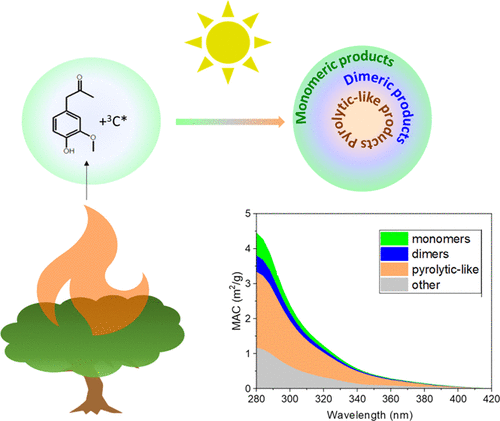当前位置:
X-MOL 学术
›
ACS Earth Space Chem.
›
论文详情
Our official English website, www.x-mol.net, welcomes your
feedback! (Note: you will need to create a separate account there.)
Molecular-Level Study of the Photo-Oxidation of Aqueous-Phase Guaiacyl Acetone in the Presence of 3C*: Formation of Brown Carbon Products
ACS Earth and Space Chemistry ( IF 2.9 ) Pub Date : 2021-08-03 , DOI: 10.1021/acsearthspacechem.1c00103 Maria V. Misovich 1 , Anusha Priyadarshani Silva Hettiyadura 1 , Wenqing Jiang 2 , Qi Zhang 2 , Alexander Laskin 1, 3
ACS Earth and Space Chemistry ( IF 2.9 ) Pub Date : 2021-08-03 , DOI: 10.1021/acsearthspacechem.1c00103 Maria V. Misovich 1 , Anusha Priyadarshani Silva Hettiyadura 1 , Wenqing Jiang 2 , Qi Zhang 2 , Alexander Laskin 1, 3
Affiliation

|
This study examined the effects of simulated solar irradiation on a model system of atmospheric aqueous secondary organic aerosol (aqSOA) formed from oxidation of guaiacyl acetone (GA) by reactions with triplet excited carbon (3C*) generated by photoexcitation of 3,4-dimethoxybenzaldehyde (DMB). Both GA and DMB are common components of biomass burning emissions, and their mixture was selected as a case study to investigate the influence of aqueous-phase photochemistry on the light absorption properties of atmospheric brown carbon (BrC) pertinent to aqSOA formation. Irradiation was performed in a photoreactor designed to mimic sunlight irradiation, and samples were collected at different times of the experiment, which lasted for 6 h. Chemical components of the samples were separated using high-performance liquid chromatography and analyzed with a photodiode array detector and Orbitrap mass spectrometer operated simultaneously to record both UV–visible spectra and high-resolution mass spectra. This allowed us to obtain molecular characterization of the aqSOA individual components, as well as information on their light-absorbing properties and how they change over time when irradiated. The results indicate that three generations of products formed at different stages of the experiment: monomeric products, dimeric products, and less polar aromatic products similar to those formed during oxygen-deprived pyrolytic processes. The monomeric and dimeric products result from oxidation reactions initiated by 3C*, while the less polar aromatic products form as a result of radical recombination. Prior to irradiation, the BrC absorbance is dominated by monomeric species, but it is later dominated by pyrolytic-like products as the monomeric and dimeric products begin to photodegrade. Comparison with previously defined BrC classes based on optical properties suggests that the aqSOA formed in this experiment initially fall outside of these classes but then become more absorbing, consistent with the “very weak” to “weak” BrC classes.
中文翻译:

3C* 存在下水相愈创木酰丙酮光氧化的分子级研究:棕色碳产物的形成
本研究研究了模拟太阳辐射对由愈创木酰丙酮 (GA) 与三重激发碳反应形成的大气含水二次有机气溶胶 (aqSOA) 模型系统的影响 ( 3C*) 由 3,4-二甲氧基苯甲醛 (DMB) 的光激发产生。GA 和 DMB 都是生物质燃烧排放的常见成分,选择它们的混合物作为案例研究,以研究水相光化学对与 aqSOA 形成相关的大气棕碳 (BrC) 光吸收特性的影响。照射在设计用于模拟阳光照射的光反应器中进行,并在实验的不同时间收集样品,持续 6 小时。使用高效液相色谱分离样品的化学成分,并使用光电二极管阵列检测器和 Orbitrap 质谱仪进行分析,同时记录紫外-可见光谱和高分辨率质谱。这使我们能够获得 aqSOA 各个组分的分子特征,以及关于它们的光吸收特性以及它们在照射时如何随时间变化的信息。结果表明,在实验的不同阶段形成了三代产物:单体产物、二聚体产物和极性较小的芳香族产物,类似于在缺氧热解过程中形成的产物。单体和二聚体产物是由下列物质引发的氧化反应产生的 以及类似于在缺氧热解过程中形成的那些极性较小的芳香族产物。单体和二聚体产物是由下列物质引发的氧化反应产生的 以及类似于在缺氧热解过程中形成的那些极性较小的芳香族产物。单体和二聚体产物是由下列物质引发的氧化反应产生的3 C*,而极性较小的芳香族产物是自由基重组的结果。在辐照之前,BrC 吸光度由单体物种主导,但后来随着单体和二聚体产品开始光降解,它由类热解产物主导。与基于光学特性的先前定义的 BrC 类别进行比较表明,在该实验中形成的 aqSOA 最初不属于这些类别,但随后变得更具吸收性,与“非常弱”到“弱”的 BrC 类别一致。
更新日期:2021-08-19
中文翻译:

3C* 存在下水相愈创木酰丙酮光氧化的分子级研究:棕色碳产物的形成
本研究研究了模拟太阳辐射对由愈创木酰丙酮 (GA) 与三重激发碳反应形成的大气含水二次有机气溶胶 (aqSOA) 模型系统的影响 ( 3C*) 由 3,4-二甲氧基苯甲醛 (DMB) 的光激发产生。GA 和 DMB 都是生物质燃烧排放的常见成分,选择它们的混合物作为案例研究,以研究水相光化学对与 aqSOA 形成相关的大气棕碳 (BrC) 光吸收特性的影响。照射在设计用于模拟阳光照射的光反应器中进行,并在实验的不同时间收集样品,持续 6 小时。使用高效液相色谱分离样品的化学成分,并使用光电二极管阵列检测器和 Orbitrap 质谱仪进行分析,同时记录紫外-可见光谱和高分辨率质谱。这使我们能够获得 aqSOA 各个组分的分子特征,以及关于它们的光吸收特性以及它们在照射时如何随时间变化的信息。结果表明,在实验的不同阶段形成了三代产物:单体产物、二聚体产物和极性较小的芳香族产物,类似于在缺氧热解过程中形成的产物。单体和二聚体产物是由下列物质引发的氧化反应产生的 以及类似于在缺氧热解过程中形成的那些极性较小的芳香族产物。单体和二聚体产物是由下列物质引发的氧化反应产生的 以及类似于在缺氧热解过程中形成的那些极性较小的芳香族产物。单体和二聚体产物是由下列物质引发的氧化反应产生的3 C*,而极性较小的芳香族产物是自由基重组的结果。在辐照之前,BrC 吸光度由单体物种主导,但后来随着单体和二聚体产品开始光降解,它由类热解产物主导。与基于光学特性的先前定义的 BrC 类别进行比较表明,在该实验中形成的 aqSOA 最初不属于这些类别,但随后变得更具吸收性,与“非常弱”到“弱”的 BrC 类别一致。




















































 京公网安备 11010802027423号
京公网安备 11010802027423号